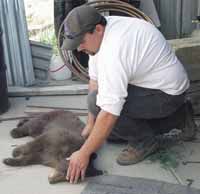| Wildlife Biologist Brad Crompton looks after a young male bear cub tranquilized at Luxury Homes in Helper. Crompton, along with Depredation Technichian Grizz Oleen, captured the animal after Luxury Home employees reported it was eating apples off a tree. DWR officers should always be contacted in the event of a wild animal entering a populated area. |
The capture of two bear cubs in Helper last week serves as a reminder that the high elevation of Carbon County can often result in wild animals entering populated areas.
Two reports of bear cubs were received by the Price Division of Wildlife Resources office on Aug. 31. One cub was found at Luxury Homes while the other was located near a church building in the city. Both cubs were tranquilized and taken by DWR officers.
According to Bill Bates, regional wildlife program manager for the Price DWR, a total of four cubs have been taken this year. Because the cubs were found alone without their mother and it is unclear whether or not the cubs are even from the same family, the pair will be transported to a bear rehabilitation facility in Boise, Idaho. There the cubs will be “fattened up” until January or February of 2005. Price DWR officers will then return the bears to an old den in Carbon County for the remainder of winter. The cubs will have a much stronger chance of surviving at that point, Bates stated.
Aside from bears, many other animals can also be rehabilitated and re-released. However, Bates said it is difficult for deer or elk to be treated and officers usually have to put them down.
When area residents come into contact with threatening or endangered wild animals near their homes, it is in the best interest of the both that the DWR is contacted to mediate the situation. Bates said all officers are specifically trained to safely remove the animal.
“Everybody has to go through an annual chemical mobilization training,” he pointed out. “We always have two of us and someone is in the position to protect the other. You just have to understand the animal and what they are doing.”
It is not only wildlife that enters the living space of humans, though. Hunters, campers and outdoor recreationalists are abundant in Carbon County and chances of encountering wildlife are much increased when people enter unpopulated wilderness.
Although most wild animals, such as bears, are afraid of people and will avoid interaction, improperly stored food can lead to unwanted situations.
“That [fear] changes as soon as they begin to associate people with a place to get food,” commented Craig McLaughlin, DWR mammals coordinator. “They start losing their fear of people and can become aggressive and dangerous.”
McLaughlin said food is what attracts bears to people. In the case of the Helper cub taken at Luxury Homes, the young bear was drawn to an apple tree on the property.
But by following a few camping rules, McLaughlin said people can virtually eliminate problems with bears. He encourages resident campers to:
•Keep campsites clean. Don’t leave garbage, food scraps and fat drippings in the fire pit, or scattered around the campsite. Instead, place all remains in an air tight container and take it home.
•Keep the cooking grills and utensils in the camping area clean.
•Don’t leave food out. Instead, store food and coolers in the trunk of a car, in the camping trailer, in a bear proof container or suspended at least 12 feet high between two trees, so bears can’t reach them. Plastic garbage cans and plastic food storage containers are not bear proof.
•Never intentionally feed bears by leaving food out for them.
•Bears have an incredible sense of smell, so make sure to cook away from the tent or sleeping area. In addition, local outdoor ehthusiastis should not sleep in the clothes in which meals were cooked or which were worn while cleaning fish.
Leave the cooking and fishing clothes along with utensils, rags and anything else used in food preparation, eating and clean up the campsite at the cooking area or sealed inside a vehicle.
McLaughlin indicates that, when outdoor enthusiasts fail to comply with the rules, there aren’t actually many alternatives left.
“The first thing we’ll do with a bear that’s just gotten into trouble is haze it with rubber bullets or hounds or capture it in hopes that the experience will scare it enough that it won’t want to visit the campground again,” he said. “This only works with bears that are brand new to the campground, however. Bears that have already associated the campground with food will come back as soon as we move them.”
McLaughlin asserts that bears have an incredible homing ability and can find their way back to an area that is as far as 100 miles away.
“It’s difficult for our regional wildlife managers to find remote sites to move problem bears to. As a result, often all we’ve done is shift the problem to a new area of the state,” he said. “The bear is used to looking to campgrounds for food, and it will roam and find a campground in the new area.”
Being responsible while enjoying the outdoors is crucial for the safety of both campers and surrounding wildlife, especially bears.
“It’s very simple to avoid putting a bear in a situation where it has to be killed to protect public safety and we hope people will follow our advice this summer,” McLaughlin concluded.
To report a wildlife situation, Carbon County residents should contact the DWR office in Price.

